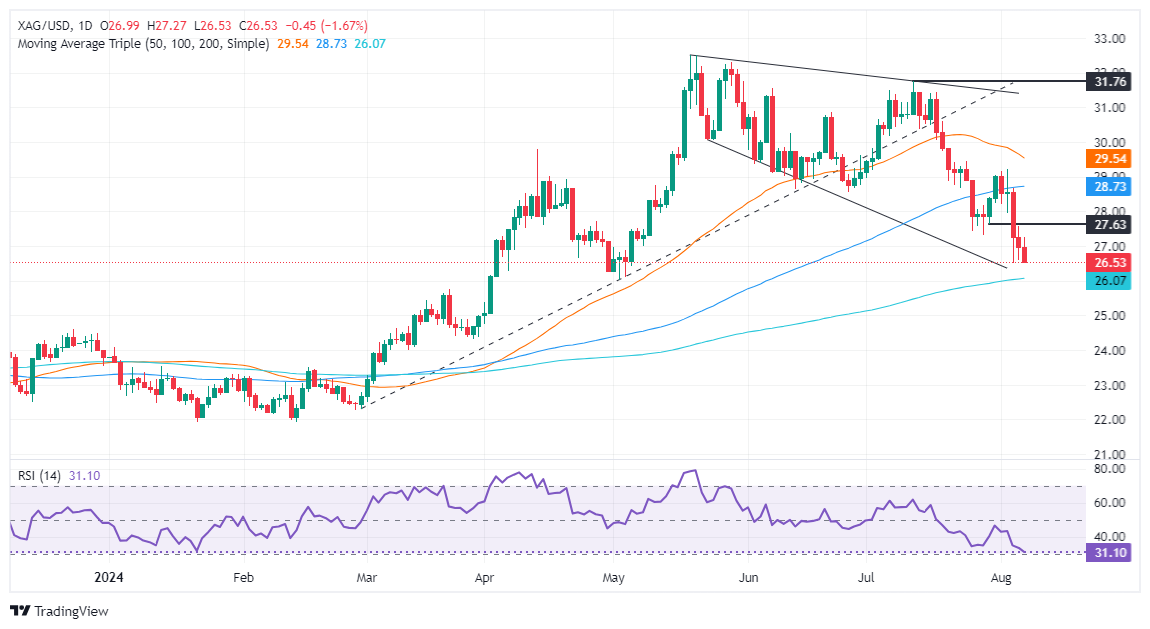Silver Price Forecast: XAG/USD sinks below $27.00 despite geopolitical jitters
- Silver drops 1.38% to $26.59, pressured by strong US Dollar.
- Key support levels at $26.51 and $26.06 eyed amid bearish momentum.
- Reclaiming $27 could push silver to test resistance at $27.56 and $28.00.
Silver's price extended its losses for the third straight day and stayed below $27.00 amid increasing geopolitical fears spurred by the Middle East conflict. Despite that, the grey metal failed to gain traction, capped by the rise of US Treasury yields and a strong US Dollar. The XAG/USD trades at $26.59, down 1.38%.
XAG/USD Price Forecast: Technical outlook
Silver's struggle to remain above $27.00 could pave the way for a deeper pullback and test key support levels. Momentum favors sellers, as the Relative Strength Index (RSI) remains in bearish territory.
The XAG/USD first support would be the August 5 low of $26.51, followed by the 200-day moving average (DMA) at $26.06. Once those levels are surpassed, the next demand zone will be the March 27 pivot low at $24.33.
Conversely, if XAG/USD makes a U-turn and buyers reclaim $27.00, this can pave the way to test the August 6 peak at $27.56. Once hurdle, the next resistance would be the $28.00 mark ahead of the August 5 high at $28.67.
XAG/USD Price Action – Daily Chart

Silver FAQs
Silver is a precious metal highly traded among investors. It has been historically used as a store of value and a medium of exchange. Although less popular than Gold, traders may turn to Silver to diversify their investment portfolio, for its intrinsic value or as a potential hedge during high-inflation periods. Investors can buy physical Silver, in coins or in bars, or trade it through vehicles such as Exchange Traded Funds, which track its price on international markets.
Silver prices can move due to a wide range of factors. Geopolitical instability or fears of a deep recession can make Silver price escalate due to its safe-haven status, although to a lesser extent than Gold's. As a yieldless asset, Silver tends to rise with lower interest rates. Its moves also depend on how the US Dollar (USD) behaves as the asset is priced in dollars (XAG/USD). A strong Dollar tends to keep the price of Silver at bay, whereas a weaker Dollar is likely to propel prices up. Other factors such as investment demand, mining supply – Silver is much more abundant than Gold – and recycling rates can also affect prices.
Silver is widely used in industry, particularly in sectors such as electronics or solar energy, as it has one of the highest electric conductivity of all metals – more than Copper and Gold. A surge in demand can increase prices, while a decline tends to lower them. Dynamics in the US, Chinese and Indian economies can also contribute to price swings: for the US and particularly China, their big industrial sectors use Silver in various processes; in India, consumers’ demand for the precious metal for jewellery also plays a key role in setting prices.
Silver prices tend to follow Gold's moves. When Gold prices rise, Silver typically follows suit, as their status as safe-haven assets is similar. The Gold/Silver ratio, which shows the number of ounces of Silver needed to equal the value of one ounce of Gold, may help to determine the relative valuation between both metals. Some investors may consider a high ratio as an indicator that Silver is undervalued, or Gold is overvalued. On the contrary, a low ratio might suggest that Gold is undervalued relative to Silver.